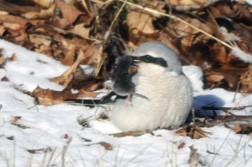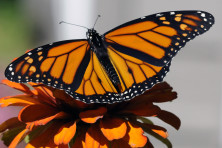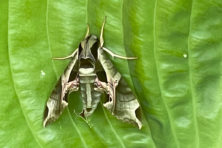Fascinating Impaler
- Share
- Tweet
- Pin
- Share
During the early 1960s my intense interest in birds grew to the point that I finally qualified and received my federal bird-banding permit and, during the next 20-some years, I handled and banded quite a few thousand birds, all small songbirds.
It was during that time that I came across an old National Geographic magazine article called “Falconry, Sport of the Kings.” As I recall it was written by two budding wildlife biologists, John and Frank Craighead, who both eventually achieved considerable fame regarding their work with wild animals, including birds of prey.
A point in the article that caught my interest dealt with some falconers in Holland who used what is called a ball-chatri (BAL-cha-tree) trap to capture their falcons during migration. The falconers, concealed within their blind, used a captive Shrike. which they tethered to an upright stand in clear sight of all oncoming hawks. The Shrike’s vision was so incredibly sharp that it saw the approaching hawks well before the falconers did. The Shrike immediately let out cries that quickly told the falconers to be on the alert.

A Northern Shrike caught a Meadow Vole and is looking for a place to impale it so it can be eaten.
The species name of the Northern Shrike is excubitor, which in Latin alludes to the bird being a sentinel. Linnaeus, who gave this bird its scientific name of excubitor, interpreted it as, “It looks out for the approach of hawks and warns little birds.” It is thought that the shrill cry of a Shrike was referred to as a “shriek,” very likely the bird’s original name which, through the years, was changed to Shrike.
Shrikes belong to the family Laniidae (Lane-EYE-ih-dee), from which comes the bird’s genus name of Lanius (LANE-e-us), meaning “butcher.” And so we have a butcher bird that acts like a sentinel. Go to practically any bird reference book and it will describe the Northern and Loggerhead Shrikes of North America as the butcher birds. This is based on their habit of impaling their victims – such as mice and small birds – on thorns that exist on, for example, thornapple or some locust trees, or even barbed-wire fences.
During my early bird-banding days I had the good fortune of meeting a Green Bay East High School student named Tom Erdman who had an incredibly strong interest in natural history. He was soon helping me band birds, and within a few years he was doing it by himself, via a sub-permit under my master license. It wasn’t long before he progressed from banding “dickey birds” (the small ones) to specializing in working with hawks, owls and eagles.
Tom discovered one of the last really good northeastern Wisconsin strongholds of Loggerhead Shrikes nesting on Scray Hill east of De Pere. He, being the complete biologist, also studied the food habits of those birds and, for example, learned that they frequently impaled large insects, such as bumble bees and grasshoppers, on the barbed wire fences.
Soon Tom had me looking for Loggerhead Shrikes too, and eventually I came upon a good population of at least a half-dozen breeding pair in north-central Door County, some of whose nestlings I banded. Fortunately other fellow banders had previously warned me about handling shrikes, to be extremely cautious of their razor-sharp bill and the speed in which they could use it.
Literature also told me that some of the reasoning behind the shrikes’ “impaling of victims” technique was due to their weak feet. The birds could hold onto their victims better when they were securely impaled on a barb or thorn. Well, the first adult shrike I handled completely erased any thought of weak feet. I thought for sure its claws were going to go completely through my leather gloves. What a grip they had! And, yes, I paid particular attention to their mandibles at all times!
A lot of these previously mentioned thoughts will be kept in mind during our Christmas Bird Count. Several Northern Shrikes have been observed by Charlotte and other friends. A few years ago I observed five different N. Shrikes. This set a record for all of my roughly 55 previous Christmas Bird Counts dating back to 1958.
One of the five N. Shrikes hovered, as though tethered on a kite string, above a field of winter wheat for as long as 20 seconds at a time, scanning the ground below for rodents. Between a half-dozen or more periods of hovering, the Shrike would fly back to the power line to rest. Never before have we witnessed this beautiful hunting display by a Shrike.
A few years ago during a Christmas Bird Count we came upon a N. Shrike very busy with its hunting, which apparently was very good. We quickly parked the car within about 50 feet of the Shrike along the very quiet side-road and turned the engine off. So intent was that bird with its food-finding mission that it appeared to pay absolutely no attention to us. What a wonderful show it put on.
To look for these birds, try driving roads through the open countryside now, especially where fallow fields exist and, along with the unplowed ground, plenty of rodents. Shrikes are loners, so don’t expect to see flocks of them.
Look for a gray, Robin-sized bird perched in a rather horizontal manner. It will flash small white wing patches in its black wings during fight. A close view will reveal a black mask through its eyes. Its heavy hooked bill is flesh-colored on the bottom mandible (unlike the Loggerhead Shrike’s bill, which is all black). The unusual bill is also notched like all raptors’ near the tip, a feature that lends itself well to tearing its victims apart.
Word from other statewide birders is that there are more Northern Shrikes than usual in the Midwest this winter. A very good accompanying thought is that, based on many years of precious observations, an invasion by Northern Shrikes frequently coincides with a southerly flight of Snowy Owls as well, so keep on the alert. This usually is not the time to be expecting to see large numbers of birds, but being able to come upon Northern Shrikes or Snowy Owls will add great excitement to your outings.


